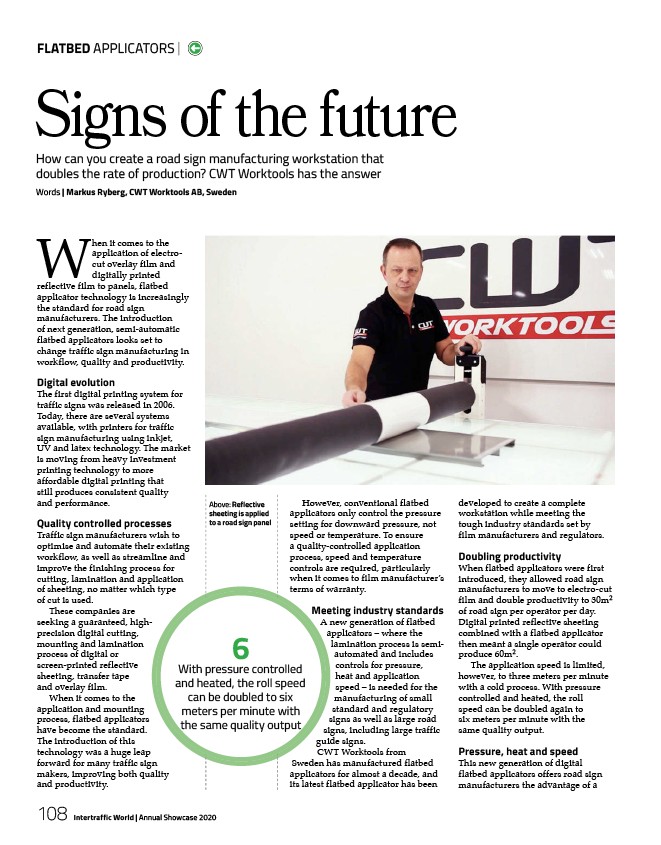
FLATBED APPLICATORS |
Signs of the future
How can you create a road sign manufacturing workstation that
doubles the rate of production? CWT Worktools has the answer
Words | Markus Ryberg, CWT Worktools AB, Sweden
Above: Reflective
sheeting is applied
to a road sign panel
When it comes to the
application of electrocut
overlay film and
digitally printed
reflective film to panels, flatbed
applicator technology is increasingly
the standard for road sign
manufacturers. The introduction
of next generation, semi-automatic
flatbed applicators looks set to
change traffic sign manufacturing in
workflow, quality and productivity.
Digital evolution
The first digital printing system for
traffic signs was released in 2006.
Today, there are several systems
available, with printers for traffic
sign manufacturing using inkjet,
UV and latex technology. The market
is moving from heavy investment
printing technology to more
affordable digital printing that
still produces consistent quality
and performance.
Quality controlled processes
Traffic sign manufacturers wish to
optimise and automate their existing
workflow, as well as streamline and
improve the finishing process for
cutting, lamination and application
of sheeting, no matter which type
of cut is used.
These companies are
seeking a guaranteed, highprecision
digital cutting,
mounting and lamination
process of digital or
screen-printed reflective
sheeting, transfer tape
and overlay film.
When it comes to the
application and mounting
process, flatbed applicators
have become the standard.
The introduction of this
technology was a huge leap
forward for many traffic sign
makers, improving both quality
and productivity.
108 Intertraffic World | Annual Showcase 2020
However, conventional flatbed
applicators only control the pressure
setting for downward pressure, not
speed or temperature. To ensure
a quality-controlled application
process, speed and temperature
controls are required, particularly
when it comes to film manufacturer’s
terms of warranty.
Meeting industry standards
A new generation of flatbed
applicators – where the
lamination process is semiautomated
and includes
controls for pressure,
heat and application
speed – is needed for the
manufacturing of small
standard and regulatory
signs as well as large road
signs, including large traffic
guide signs.
CWT Worktools from
Sweden has manufactured flatbed
applicators for almost a decade, and
its latest flatbed applicator has been
developed to create a complete
workstation while meeting the
tough industry standards set by
film manufacturers and regulators.
Doubling productivity
When flatbed applicators were first
introduced, they allowed road sign
manufacturers to move to electro-cut
film and double productivity to 30m2
of road sign per operator per day.
Digital printed reflective sheeting
combined with a flatbed applicator
then meant a single operator could
produce 60m2.
The application speed is limited,
however, to three meters per minute
with a cold process. With pressure
controlled and heated, the roll
speed can be doubled again to
six meters per minute with the
same quality output.
Pressure, heat and speed
This new generation of digital
flatbed applicators offers road sign
manufacturers the advantage of a
6 With pressure controlled
and heated, the roll speed
can be doubled to six
meters per minute with
the same quality output